Introduction
Zimbabwe offers excellent birding, with the chance to see species which are rare and of restricted range. The roads and the services infrastructure within the country make getting around easy, and the availability of good field guides, and well run national parks and reserves make birding easy. Not only birds, but large game abounds, and no visit should miss the spectacular Victoria Falls, where the rare Taita Falcon can be found also. The eastern highlands on the border with Moçambique hold many species of interest such as Swynnerton's Robin, Chirinda Apalis, Robert's Prinia and Red-faced Crimsonwing. Both Bradfield's Hornbill and Boulder Chat are most easily found in Zimbabwe, the latter being practically endemic.
Flights and Getting There
Direct flights from London to Harare, the capital, are available on both British Airways and Air Zimbabwe, the later also operating all internal flights. I flew Air Zimbabwe between Harare and Victoria Falls, and found the service punctual and of reasonable quality. However, be warned - they only allow flight reconfirmation a maximum of three days in advance and automatically cancel unconfirmed reservations 24 hours before the flight. Generally this would not present a problem, but for the truly appalling telephone system in Zimbabwe. I found it impossible to get a connection to Harare from Mutare (the second largest city), and the Air Zimbabwe office in Victoria Falls took over an hour to get through to reconfirm my flights.
Visas
No visas are required by holders of British, and most European passports. Immigration are particularly strict on return tickets and currency. Make sure you have the name, and complete address of where you intend to stay, at least for the first night. Yellow fever inoculation certificates are checked.
Accommodation
Accommodation in Harare is in short supply, and consequently not cheap. However, for the rest of the country, plenty of accommodation can be found in the tourist areas, and most national parks have excellent facilities. It is advisable to make advance reservations if visiting Victoria Falls during the peak season (August and December). Places I found particularly good, or bad, are mentioned.
Money
The official currency is the Zimbabwe Dollar (Z$). Currency regulations are enforced, with visitors receiving currency forms on arrival, which must be produced whenever money is exchanged. On departure, any unspent local currency is refunded as US$ travellers cheques only. There is a US$20, airport departure tax, payable in hard currency.
Language
Language English, the official language, is widely spoken.
Travel and Getting Around
Car hire is a little more expensive than in Europe, and unlimited mileage only available on hires of longer than six days. I hired with Avis throughout (and wished I hadn't), as the only Hertz car I had in Harare was excellent. Due to the foreign currency regulations, new cars and spares are in very short supply, resulting in poor quality cars with high mileages.
Main roads are in excellent condition - wide, straight, well maintained, with remarkably little traffic. Previously, parts of western Zimbabwe were unsafe, but the whole country can now be safely travelled. For those using public transport, there are plenty of buses, or simply hitch-hiking, which seems to be the national pastime in Zimbabwe. One important note: Jeans are not as accepted in Zimbabwe as in Europe, and many ordinary restaurants will refuse entry to those wearing jeans and/or T-shirts.
Climate and When to go
The 1000 metre altitude plateau, upon which most of the country sits, has a tempering effect on the climate, which is hot and dry. The rains starting in October, continuing through to April, coincide with the breeding season for most species. The ideal time therefore for a visit is October through December, coinciding with the austral spring and early summer.
References
Berruti, A. and Sinclair, J.C. (1983). Where to Watch Birds in Southern Africa. Struik, Cape Town. An immensely useful overview of the birding areas, complete with maps, details of access, birds and habitats. Unfortunately now out of print, and difficult to obtain.
Brown, L.H., Urban, E.K., and Newman, K. (1982). The Birds of Africa. Volume I. Academic Press, London. Comprehensive and authoritative, this, combined with volumes II and III, has become the standard reference for West African non-passerines. Volume 4 covering the first of the passerine species has now been published.
Clements, J. (1981). Birds of the World: A Checklist. Facts on File, USA. The 1991 update is now available. Collar, N.J., and Andrew, P. (1988). Birds to Watch. ICBP, Cambridge. UK. Useful summary of current status of each threatened species.
Collar, N.J., and Stuart, S.N. (1985). Threatened Birds of Africa and Related Islands, The ICBP/IUCN Red Data Book, Part I. I.C.B.P., Cambridge, UK. Collar, N.J., and Stuart, S.N. (1988). Key Forests for Threatened Birds in Africa. International Council for Bird Preservation Monograph No. 3. I.C.B.P., Cambridge, UK.
Crowther, G. (1986). Africa on a Shoestring. Lonely Planet. Useful information and background reading.
Fry, C.H., Keith, S., and Urban, E.K. (1988). The Birds of Africa. Volume III. Academic Press, London.
Greensmith, A and E.A. (1988). The Birds of South Africa, Namibia and Zimbabwe. 2nd November 1987 to 13th December 1987. Unpublished trip report.
Haltenorth, T., and Diller, H. (1980). A Field Guide to the Mammals of Africa. A good mammal guide such as this will be indispensable on any trip to Southern Africa.
Howard, R., and Moore, A. (1991). A Complete Checklist of the Birds of the World. Academic Press, London.
MacLean, G. (1985). Roberts' Birds of Southern Africa. New Holland Publishers. A comprehensive field guide covering all species found in Zimbabwe. To take this, or the Maclean reference, is a matter of personal choice.
Newman, K. (1988). Birds of Southern Africa. Southern Book Publishers.
Urban, E.K., Fry, C.H., and Keith, S. (1986). The Birds of Africa. Volume II. Academic Press.
Taxonomy
Taxnomy follows Clements, J. (1981) Checklist of the Birds of the World.
Itinerary and Suggestions
Two weeks would be an ideal stay. This would allow coverage of all the important sites at a relatively easy pace. The nine days I spent were enough to see most of the specialities, and enabled me to cover the eastern highlands, Victoria Falls, and Harare areas. With limited time, the areas and species on which to concentrate are:
Lake McIlwane National Park for Boulder Chat, plus a host of Miombo woodland endemics such as Racquet-tailed Roller, Whyte's Barbet, Stierling's Barred Warbler, Spotted Creeper, Mashona Hyliota, Miombo Grey Tit, and Green-capped Eremomela. Other good birds include African Scops Owl, Bennett's Woodpecker and Violet-backed Sunbird.
The Eastern Highlands for Chirinda Apalis, Roberts' Prinia, Swnnerton's Robin, Broad-tailed Warbler, Black-fronted, Gorgeous, Olive, and Orange-breasted Bush-Shrikes, and Red-faced Crimsonwing. This is also one of the better places in Africa for Blue Swallow which is a breeding visitor from October onward.
Victoria Falls area for Slaty Egret, Taita Falcon, African Hobby, Rock Pratincole, White-crowned Plover, Red-capped Crombec, Collared Palm-Warbler, and White-rumped Babbler etc.
Hwange National Park for Swainson's Francolin, Pearl-spotted Owlet, Bradfield's Hornbill Southern Pied Babbler, Black-chinned Prinia, Crimson-breasted Boubou, Brubru, White-crowned Shrike, and Violet-eared Waxbill etc.
26 Aug 90 - Arrived Harare. Lake Mcllwane National Park.
27 Aug 90 - Flew to Victoria Falls. Zambezi River Drive, Victoria Falls National Park.
28 Aug 90 - Victoria Falls, Zambezi National Park, Victoria Falls area.
29 Aug 90 - Kazungula, Zambezi National Park.
30 Aug 90 - Hwange National Park.
31 Aug 90 - Hwange National Park.
01 Sep 90 - Hwange National Park. Flew to Harare. Drove to Vumba. 'Seldomseen'.
02 Sep 90 - Seldomseen, Vumba Botanic Gardens.
03 Sep 90 - Seldomseen, Thompson's Vlei.
04 Sep 90 - Drove to Harare. Return flight.
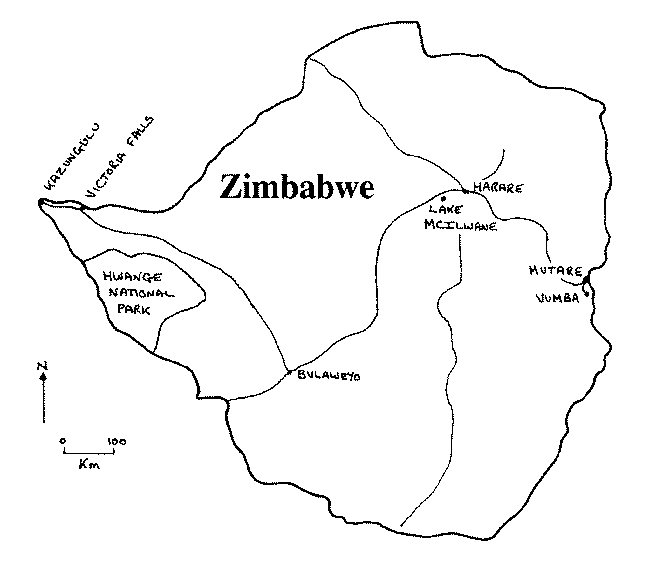
Personal Experiences
26 Aug. Arrived at Harare from Lilongwe, Mala at 11h30. On trying to reconfirm my return flight I was told it would not be possible until three days before! As I had arrived one day later than planned, my previously reserved car from Avis had been cancelled, and I was lucky to get the last Hertz car available in town that day. Drove out of Harare to Lake Mcllwane National Park less than an hour away, where I started by looking around the tourists chalets for Boulder Chat with no success. Proceeded to Bushman's Point where a walk around the headland produced White-throated Robin-Chat, Crested Barbet and Natal Francolin. En route back to the chalets saw plenty of mammals including Zebra, Giraffe and White Rhino. A further couple of hours effort around the chalets was eventually rewarded with a pair of Boulder Chat. Drove back to Harare where I checked into the Jameson Hotel - pricey at US$70 a night, but the cheapest hotel which wasn't a dive that I could find.
27 Aug. Took a taxi to the airport (Z$25) in time for the 08h00 internal flight to Victoria Falls, where I collected reserved car from Avis, a large Peugeot 504, which almost immediately started giving problems. Next spent over an hour in the Air Zimbabwe office, who in their wonderful efficiency had cancelled all my flight reservations. As August is peak tourist season I had to try several hotels, but eventually found one night available at the Rainbow Hotel for Z$113. In the heat of the day, birded along the Zambezi River trail and then entered the Victoria Falls Park to do the tourist bit. Spent the last two hours of light perched at the head of gorge waiting in vain for Taita Falcon to put in an appearance, until slung out of the park at the 18h00 closing hour. In the evening was refused entry into the Rainbow Hotel's restaurant as I was wearing jeans, so went to the Whimpy in town. An evening spot-lighting drive along the Zambezi Drive produced nothing.
28 Aug. Making a determined effort today to find Taita Falcon I started with at 06h00 with a walk through the Victoria Falls Hotel to get at a view of gorges, numbered two and three (see map) behind the hotel. After an hour with no luck, slipped under the security fence and walked out to a good observation area for gorges three and four. By 10h00 gave up and returned to the Rainbow Hotel to check-out. Telephoned a few hotels and found a room for two nights at the A'Zambezi River Lodge at Z$110. I would recommended this lodge for future visitors. Here I ran into an American birding tour with a local leader and learnt that Taita Falcon has now moved away from the Victoria Falls area due to egg-collecting pressure, and he kindly gave me a new locality to try. I next ventured into the Zambezi National Park, but with little birding success, though many animals including a pair of elephant which took exception to the car and decided to charge it. After a couple of hours the car was misfiring badly, so I turned around and just about made it back to the Avis office where it was replaced by a Mazda 323. Stocked up on food for the Hwange National Park and then continued to the Taita Falcon site where as in addition to excellent views of that species, had Verreaux's Eagle soaring at less than 50 metres distance and toward evening an African Hobby chasing African Black Swift.
29 Aug. Took the Kazungula road though the Zambezi National Park. Along this excellent paved road I soon discovered that my Mazda had appalling vibration through the steering column effectively limiting speed to 60 km/h. Lots of elephant, buffalo and zebra en route and I arrived at the Botswana border by 08h00. Parked at the police station and asked permission to view the river behind the station. For the next hour walked slowly eastward along the river obtaining very close views of hippo, after which time one of the policemen was waving for me to return. However, having just discovered a Slaty Egret in the scope I temporarily went deaf and blind and continued to grill the egret and a Buffy Pipit which had wandered past, until dragged off to the police captain who informed me that: a) it was dangerous to walk along the river as there are lions and elephants, and b) all the land was private. It was suggested that I pay a visit to the owner who ran a lodge just down the road. Having arrived at the lodge to find that everyone was out on game viewing I used the opportunity to wander a short way westward along the river to where a lion kill was attracting numerous vultures. By lunch the owner returned but was not interested in taking me out on the river. The guy was a really objectionable, and took great pleasure in telling me that this was an exclusive lodge, available only to those with loads of money. As no other access was available to the river without a four wheel drive vehicle, I reluctantly headed back to Victoria Falls. (I have since discovered that this whole thing is a scam, as the land is not really private, but the lodge owner obviously has an interest in keeping people away). As there was very little bird activity in the heat of the day I decided to tick off Zambia, so crossed the border for a couple of hours. If you decide to cross, take as little with you as possible. One camera and a maximum of Z$40 are permissable. The late afternoon was spent birding along the Kazungula road.
30 Aug. Drove to Hwange National Park, entering the eastern side at Robin's Camp. As the accommodation there was fully booked I spent most of the day slowly driving the 80 km to Sinamatella Camp. Much better birding than in the Zambezi Park, and I soon had several new species including Swainson's Francolin, Magpie Shrike, and Steel-blue Widowfinch. Arrived at Sinamatella Camp by mid-afternoon and luckily managed to secure the last available chalet on a cancellation. Late afternoon spent sitting with the telescope outside the restaurant, which perched on a small escarpment, results in phenomenal views across the park. Highly recommended.
31 Aug. A flat tyre overnight and no wheel spanner in car (well done Avis again!) delayed the day's start waiting for the park workshop to open. Spent the majority of the day in a slow drive to the Main Camp. There was a noticeable difference between habitats and species in the two halves of the park. Some good birds seen including Pearl-spotted Owlet, Red-eyed Francolin, Southern Pied Babbler and Bradfield's Hornbill. After dark I left the park and drove to the Baobab Hotel (Z$60) in Hwange town.
01 Sep. A couple of hours spent birding along the road leading to Robins Camp before catching the 10h00 flight to Harare. Collected car from Avis and started off toward Mutare and the eastern highlands. After 10 km returned the car due to chronic misfiring. As no cars were ready, I took a just-returned, dirty one with faulty windscreen wipers and no petrol cap -at least it was drivable! Drove the 300 km to Vumba in about 4 hours arriving at Alec Manson's property, 'Seldomseen', by 16h00. Unfortunately Alec's cottages were full so I spent a couple of hours birding around his property and then headed back down the hills to the White Horse Inn. A nice place for Z$80, but again no jeans in the restaurant.
02 Sep. Woke up to rain and fog! Back up the hill to Alec's for breakfast and a couple of hours wait for improvement in the weather. Gave up waiting and went out anyway with Peter, the handyman/bird guide, and found a few of the special species such as Chirinda Apalis, Swynnerton's Robin and Roberts' Apalis. On Alec's suggestion the afternoon was spent in the Vumba Botanical Gardens where with improving weather I managed to pick up Black-fronted and Olive Bush-Shrikes, Red-faced Crimsonwing, Lemon Dove and African Goshawk. Overnight in Alec's 'Twin Streams' Cottage.
03 Sep. An excellent morning spent birding around Alec's property with Peter, where with the help of much better weather we were able to find all the species previously missed including an out-in-the-open Gorgeous Bush-Shrike. Afternoon spent in the Thompson's Vlei Nature Reserve just outside Mutare.
04 Sep. Drove back to Harare and took 15h00 return flight.
Birding Sites
The figures given for observations of each species are bird-days. The letter C denotes that the species was common or fairly common.
Lake McIlwane Recreational Area
Two distinct areas at McIlwane, the bird sanctuary and the game park, are found together under the title of the McIlwane Recreational Area. Access to the sanctuary is by permit only. Fortunately all the birds of interest can be found in the game park, which is open daily, with a small admission charge. Chalets are available, and can be booked in advance through the National Parks Booking Office in Harare. Camping is also possible. Being on the doorstep of Harare, 33 km to the west, on the Bulaweyo road, the area is a major attraction at weekends, and best avoided at that time. The park is well signposted, but remember to follow signs to the game park, not the bird sanctuary. The habitat is predominantly Miombo woodland interspersed with grassy vleis and granite koppies. Check the boulders around the chalets for the Boulder Chat. In the Miombo woodland look for specialities such as Whyte's Barbet, Racket-tailed Roller, Green-capped Eremomela, Stierling's Camaroptera, Miombo Grey Tit, Mashona Hyliota and Violet-backed Sunbird. At Bushman's Point, where you are free to walk around, it should be possible to find Natal Francolin, White-throated Robin-Chat, Crested Barbet and Mocking Chat.
Species observed at Lake McIlwane Recreational Area:
Ostrich 10+ |
Fork-tailed Drongo C |
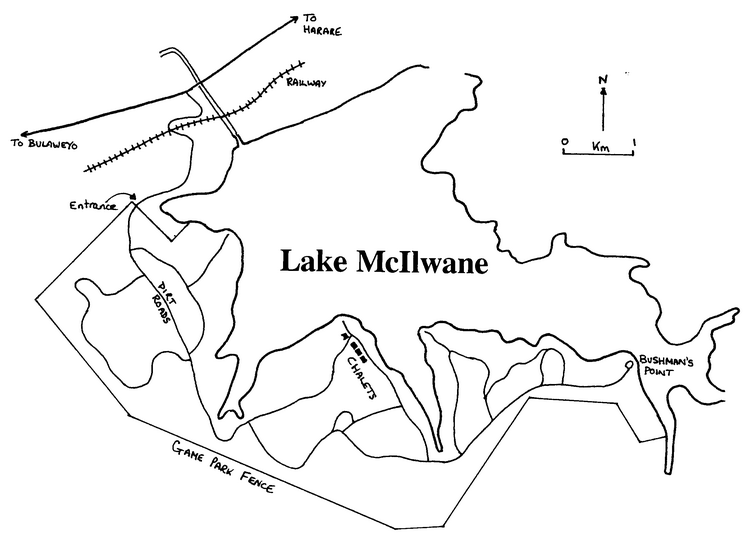
Victoria Falls National Park and Zamebzi National Park
Not to be missed. Not only are the falls a superb natural spectacle, but the area holds many birds of interest, and makes an ideal base for a few days. Of the many hotels available, the colonial Victoria Falls Hotel is a tourist attraction in itself, though the price will deter most from staying there. The falls attracts thousands of tourists, so advance reservations for both hotels and hire cars are essential during the peak season of July/August and December/January. I recommend the A'Zambezi River Lodge, which is situated on the river a few kilometres from town. Another possibility is the self-catering chalets in the Zambezi National Park. Within the Victoria Falls National Park, open between 06h00 and 18h00, a paved walkway runs along the opposite edge of the gorge into which the water plunges 100 metres below. The base of the falls is only accessible from the Zambian side, and day-tripping is common. There are several good viewpoints into the gorge where the common species are African Rock Martin, African Black Swift and Red-winged Starling. Taita Falcon could be observed in any of the gorges, though its numbers are declining due to egg collecting pressure. Each gorge is numbered, with the first gorge into which the water plunges, numbered one (see map). Exploring the gorges behind the Victoria Falls Hotel should be worthwhile for a range of species, and the 3 km of footpath along the river from the falls to the A'Zambezi River Lodge has Rock Pratincole, White-crowned Plover, and Collared Palm-Warbler. The Zambezi National Park can be explored from the dirt road which runs through the park parallel with the river. Away from the river the habitat is mixed dry woodland with grassy areas and a few pans. Many bird species occur, though in August I found the area very hot, dry and relatively birdless.
Species observed at Victoria Falls National Park and Zamebzi National Park:
Long-tailed Cormorant C |
Bearded Woodpecker 1 |
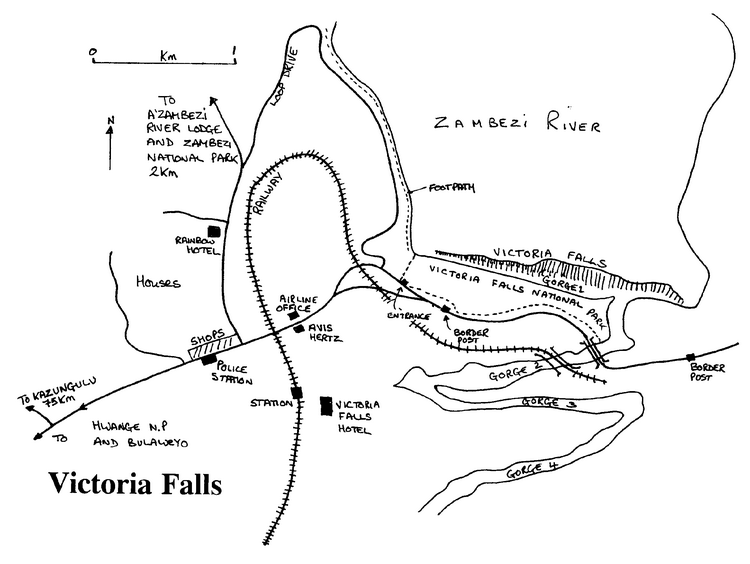
Kazungula
This area, 75 km west of Victoria Falls, on the Botswana border, is reached via the newly paved road running through the centre of the Zambezi National Park. The road is little used and wild animals abound. Habitat is primarily mixed woodland, and birding anywhere along the road could be productive. Just before reaching the border control post there is a signpost on the right to the police station. Turn hard right here and follow the road 2-3 km to the station. You pass the private safari lodge on your left, and will now be running parallel to the river back toward Victoria Falls. This is the old road. The police station or the lodge is the only readily accessible place from which to view the river. However, for those with a four wheel drive vehicle, an old road has tracks down to the river. The police are unlikely to let you wander on foot along the river, so try asking at the private safari lodge just before. The best way to work this area would be by boat. One possibility, which I didn't try, would be to cross the border and hire a boat and driver there, as many villagers live on the Botswana side. The star attraction is the Slaty Egret, which regularly occurs. Other interesting birds include Long-toed Plover, White-headed Plover, Red-capped Crombec, and White-rumped Babbler.
Species observed at Kazungula:
Great Cormorant C |
Little Bee-eater 2 |
Hwange National Park
The premier national park in Zimbabwe, and well worth the visit. As well as all the usual animals, Hwange has the largest concentration of African Wild Dog remaining, about 200. The nearest entrance to Victoria Falls, at Robin's Camp, lies an hour's drive to the south on the Bulaweyo road. The habitat is mainly mopane and mixed woodland with many artificial pans. Three camps with self-catering chalets, petrol, basic supplies and restaurant facilities, are positioned in the centre, and at the western and eastern edges of the park. All three, Robin's, Sinamatella and Main, are well signposted from the main road. As the park is so large, on leaving any camp you are required to fill in cards of your proposed route for the day. A search party is dispatched for those not arriving at their specified destinations by 18h00. Only roads in the western part of the park are paved, though all are passable to two wheel drive vehicles (at least in the dry season). I found the western half, between Main and Sinamatella camps, the most productive. Bradfield's Hornbill is a major attraction, as this is one of the few places in southern Africa where it is common. Other birds of interest include Red-crested Bustard, three species of Sandgrouse, Pearl-spotted Owlet, Southern Pied Babbler, Crimson-breasted Boubou, and Black-eared Seedeater. At least two and preferably four days are required to work the area thoroughly.
Species observed at Hwange National Park:
Ostrich 1 |
Southern Yellow-billed Hornbill C |
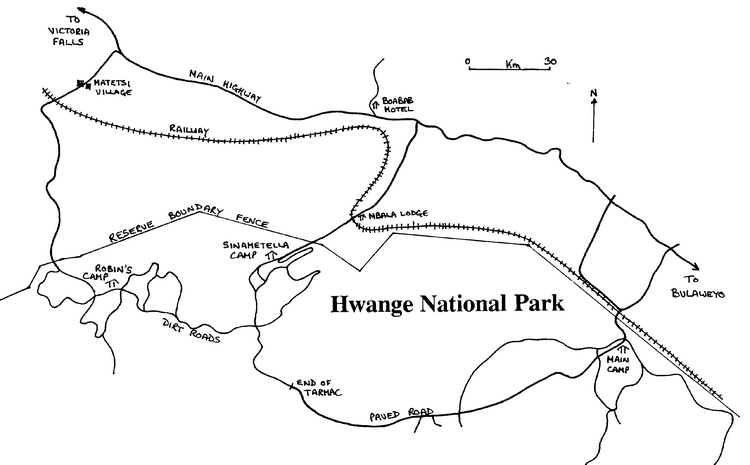
Eastern Highlands - 'Seldomseen' and Vumba Botanic Gardens
The highlands of eastern Zimbabwe need to be visited to find such local species as Blue Swallow, Swynnerton's Robin, Chirinda Apalis, Roberts' Prinia, and Red-faced Crimsonwing. Of several areas which can be visited, the most accessible and well staked-out is the area above Mutare, around Vumba (sometimes written BVumba) and the 'Seldomseen' Field Study Centre. The study centre is privately owned and run by Alec and Cecilia Manson, with accommodation consisting of two small, self-catering chalets. These cost Z$60 per day and sleep up to four people. Meals can also be provided by the Manson's. Write in advance to arrange both accommodation and a session with Peter, a local bird guide. Address: Seldomseen Field Study Centre, P.O.Box 812, Mutare. Alternative accommodation is available at the Leopard Rock Hotel and White Horse Inn (see map). From Mutare, follow signs to Vumba. At the 24.5 km post turn left onto Nyamheni Road, and after a further 800 metres watch for signs to 'Seldomseen'. The habitat is sub-montane forest and rolling grassland. The Blue Swallow is a common breeder arriving late October. As the weather is variable, plan a day spare somewhere in your itinerary. The Vumba Botanic Gardens being slightly lower in altitude, can be clear when rain is falling higher up. They also hold many of the species of interest. There is a Z$1 entrance fee. To get there from 'Seldomseen', continue past the Nyamheni Road turn-off, through the Bunga Forest, for 2.5 km and turn left onto the road which leads to the gardens.
Species observed at 'Seldomseen':
African Black Duck 2 |
Yellow-throated Warbler 3+ |
Species observed at Vumba Botanic Gardens:
African Goshawk 1 |
Dusky Flycatcher C |
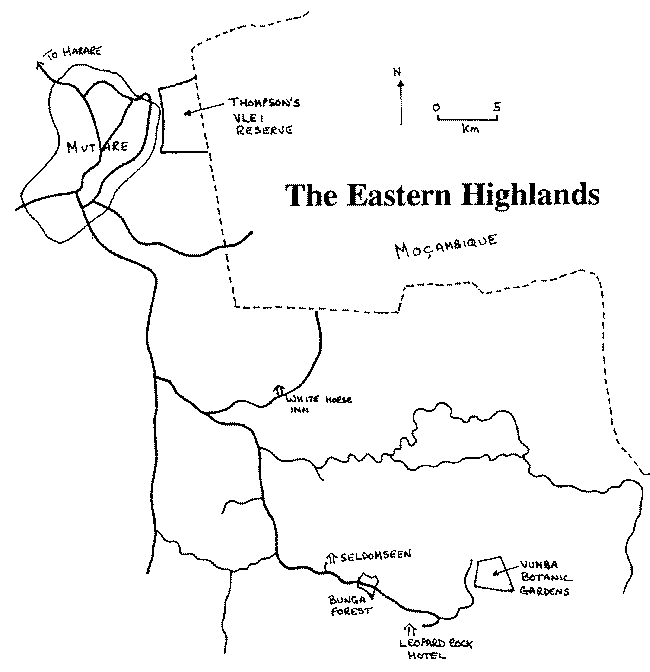
Thompson's Vlei
A small nature reserve, on the eastern outskirts of Mutare, which is popular with the local habitants, and best avoided at weekends. The reserve is well signposted from the centre of town, though it has several local names; Cecil Kop Nature Reserve, Tiger's Kloof Dam, Mutare Game Park and finally Thompson's Vlei. Although not known as a hot birding spot, this was the only place I saw Crowned Eagle, Whyte's Barbet, Black Cuckooshrike, and Thick-billed Weaver.
Species observed at Thompson's Vlei:
Hammerkop 1 |
Terrestrial Bulbul 1 |
Systematic List
Systematic list of birds observed. A toal of 279 species were recorded.
